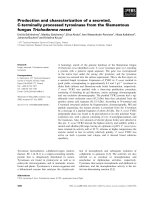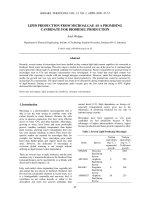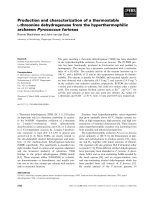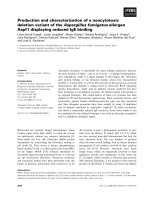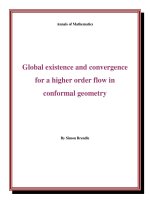Production inventory policy under a discounted cash flow
Bạn đang xem bản rút gọn của tài liệu. Xem và tải ngay bản đầy đủ của tài liệu tại đây (80.38 KB, 12 trang )
Yugoslav Journal of Operations Research
15 (2005), Number 2, 289-300
PRODUCTION INVENTORY POLICY UNDER A
DISCOUNTED CASH FLOW
Chao-Ton SU
Department of Industrial Engineering and Engineering Management
National Tsing Hwa University, Taiwan
Cheng-Wang LIN
Department of Industrial Engineering and Management
National Chiao Tung University, Taiwan
Received: October 2002 / Accepted: August 2004
Abstract: This paper presents an extended production inventory model in which the
production rate at any instant depends on the demand and the inventory level. The effects
of the time value of money are incorporated into the model. The demand rate is a linear
function of time for the scheduling period. The proposed model can assist managers in
economically controlling production systems under the condition of considering a
discounted cash flow. A simple algorithm computing the optimal production-scheduling
period is developed. Several particular cases of the model are briefly discussed. Through
numerical example, sensitive analyses are carried out to examine the effect of the
parameters. Results show that the discount rate parameter and the inventory holding cost
have a significant impact on the proposed model.
Keywords: EMQ, discounted cash flow, optimal production scheduling.
1. INTRODUCTION
The standard Economic Manufacturing Quantity (EMQ) model assumes a
constant and known demand rate over an infinite planning horizon. Mak [16] proposed a
production lot size inventory model with a uniform demand rate over a fixed time
horizon. However, most items experience a variable demand; they are varied with time.
Numerous research efforts have been undertaken to extend the basic EMQ model by
relaxing various assumptions so that the model conforms more closely to a real world
situation. Bhunia and Maiti [2] and Goswami and Chaudhuri [9][10] relaxed the
290
C.-T. Su, C.-W. Lin / Production Inventory Policy Under a Discounted Cash Flow
assumption of a constant demand. They considered the inventory model of the
assumptions that the demand rate changes linearly with time. Hariga [13], Bose et al. [3]
and Hong et al. [15] considered the inventory model with time-proportional demand.
Wee [26], Mandal and Phaudar [17] and Urban [24] discussed the inventory model with
an inventory-level-dependent demand rate. In addition, Su and Lin [22] solved a
production inventory model for variable demand and production. In this model, three
market demand rates are addressed.
The effect of production rate is so vital in many production inventory systems
that it cannot be disregarded. To incorporate the production rate, Goswami and
Chaudhuri [10] developed an order-level inventory problem of time dependent
deteriorating item with and without backlogged shortages in which the finite production
rate is proportional to the time dependent demand rate. Balkhi and Benkherouf [1]
considered a production lot size inventory model with arbitrary production and demand
rate depending on the time function. Furthermore, Bhunia and Maiti [2] assumed that the
production rate is a variable. They also presented inventory models in which the
production rate depends on either on-hand inventory or demand. In practice, demand and
inventory level may influence the production. The demand decreases (or increases) may
cause the manufacturers’ decision to decrease (or increase) their production as well.
Besides, the production rate may either increase or decrease with the inventory level.
Thus, the effect of inventory on production rate warrants further study. In the meantime,
Su et al. [21] developed a production inventory model in which considers the dependence
of production rate on the demand and inventory level.
Although the assumptions underlying the standard EMQ inventory models seem
restrictive, the model has been widely used in practice. However, they almost neglected
the time values of cash flow. In other words, the same cash amount will possess different
money value at different future time. This situation generally arises in the case of
inventories of highly demandable products. When market demand goes up, the customers
obviously consume more, thus the managers have to increase the production and
inventory. The production scheduling and periodic inventory of the items are in need of
operating the system economically.
Sarker et al. [19] developed an optimal payment time under the permissible
delay in payment for products with deterioration. Gurnani [12] applied the discounted
cash flow (DCF) approach to the finite planning horizon model in which it is a given
constant. Trippi and Lewin [23] adopted a DCF over an infinite horizon. Dohi et al. [7]
proposed optimal inventory policies for an infinite time span taking account of time value
that differs from Trippi and Lewin [23] and Gurnani [12]. Chung and Kim [5] also
suggested that the assumption of the infinite planning horizon is not realistic and called
for a new model that relaxes the assumption of the infinite planning horizon. To be more
realistic, Moon and Yun [18] examined the DCF over the finite planning horizon, which
is a random variable. They did not present a production inventory model under the
condition of considering a DCF. Hence, the EMQ computed from the standard model
would have to be extended to reflect this DCF. To eliminate the cost of holding, the firm
may undertake detailed production schemes.
We extended the models of Su and Lin [22] and Bhunia and Maiti [2], allow the
time value of money and incorporate a finite production rate which is proportional to
both the demand rate and the inventory level. A finite time-horizon production inventory
model follows the approach of Su and Lin [22] and Bhunia and Maiti [2] with a linear
C.-T. Su, C.-W. Lin / Production Inventory Policy Under a Discounted Cash Flow
291
time-dependent demand rate. The mathematical formula of the expected cost function is
derived. Then, the optimal production scheduling period, maximum inventory level can
be easily solved by using Intermediate Value Theorem method and the theory of
majorization. A numerical example is given to illustrate the use of the proposed model.
Finally, we also briefly discuss the sensitivity of these solutions to changes in underlying
parameter values as well as the advantages of the proposed model are addressed in the
conclusions.
2. ASSUMPTIONS AND NOTATIONS
The mathematical model of the production inventory problem considered in this
paper is developed on the basis of the following assumptions and notations. Additional
notations will be introduced later when needed.
1. A single item is considered over a prescribed period of T units of time,
where T = t1 + t2 ; t1 and t2 are the durations of the production scheduling
period and after the production period, respectively.
2. The demand rate D(t ) changes linearly with time t , i.e. D(t ) = α + β t ,
where α , β > 0 .
3.
4.
5.
6.
7.
8.
At time t (0 ≤ t ≤ T ) , the on-hand inventory is I (t ) .
Production rate, P (t ) , at any instant depends on both the demand and the
inventory level. That is at time t (0 ≤ t ≤ t1 ) , P (t ) = a + bD(t ) − cI (t ) , a > 0,
0 ≤ b < 1 , and 0 ≤ c < 1 .
Shortages are not allowed.
The inventory system involves only one stocking point; I m represents the
maximum inventory level.
A DCF approach is adopted to consider the time value of money. The
discount rate r is compounded continuously, 0 ≤ r ≤ 1 , where the present
value of a unit of cost after a time t is e− rt .
The relevant costs are the inventory holding cost Ci per unit per time unit
and the setup cost Cs per new cycle, which are all known and constant
during the period T .
3. THE MATHEMATICAL MODEL
Based on the above assumptions and notations, the inventory level starts at a
time t = 0 and reaches I m maximum level after t1 time units have elapsed. Then the
production is stopped, the stock level declines continuously and the inventory level
becomes zero at time t1 + t2 (= T ) . Our purpose is to find out the optimal values of t1 , T
and I m that minimize the average cost K over the time horizon [0, T ] .
292
C.-T. Su, C.-W. Lin / Production Inventory Policy Under a Discounted Cash Flow
The change in the inventory level, dI (t ) during a small interval of time dt is a
function of the production rate P (t ) , demand rate D (t ) , and the remaining inventory.
Thus, the expression for the differential equations governing the stock status during
period [0, T ] can be written as
dI (t )
= P(t ) − D(t ) = a + ( b − 1) (α + β t ) − cI (t ) , 0 ≤ t ≤ t1 ,
dt
(1)
dI (t )
= −(α + β t ) , t1 ≤ t ≤ t1 + t2 .
dt
(2)
and
Using the boundary conditions, i.e. I (t ) = 0 at t = 0 ; I (t1 ) = I m at t = t1 ; and
I (T ) = 0 at t = T . After having adjusted the constants of integration, Eqs. (1) and (2) are
clearly equivalent to the following equations
∫
I (t ) =
t
0
=
⎡⎣ a + ( b − 1) ⎤⎦ (α + β t ) e ∫
t
e ∫0
ctdt
dt
ctdt
t
a
⎡⎣1 − e− ct ⎤⎦ + ( b − 1) e− ct ∫ (α + β t )ect dt = M ⎡⎣1 − e− ct ⎤⎦ + Nt , 0 ≤ t ≤ t1 , (3)
0
c
where M =
a + (b − 1)α (b − 1) β
(b − 1) β
−
, and N =
,
c
c
c2
and
I (t ) = − ∫
t1 + t2
t
(α + β t )dt = α (T − t ) +
β
2
(T 2 − t 2 ) , t1 ≤ t ≤ t1 + t2 .
(4)
Again I (t1 ) = I m ; thus
β
I m = M ⎡⎣1 − e − ct1 ⎤⎦ + Nt1 = α t2 + (t22 + 2t1t2 ) .
2
(5)
The relationship between t1 and t2 is defined by the equation
t2 =
−(α + β t1 ) + (α + β t1 ) 2 + 2 β ⎡⎣ M (1 − e − ct1 ) + Nt1 ⎤⎦
β
.
(6)
The present value of the holding cost during the period [0, T ] is obtained by
discounting Ci I ( t ) at a rate of r , i.e. Ci I ( t ) e − rt . According to the above arguments, the
present value of the holding cost can be shown as
C.-T. Su, C.-W. Lin / Production Inventory Policy Under a Discounted Cash Flow
t1
t1 + t2
0
t1
Ci ∫ I (t )e − rt dt + Ci ∫
= Ci ∫
t1
0
{M ⎡⎣1 − e
− ct
293
I (t )e− rt dt
}
t1 + t2
⎤⎦ + Nt e − rt dt +Ci ∫
t1
β 2 2 ⎤ − rt
⎡
⎢α (T − t ) + 2 (T − t ) ⎥ e dt .
⎣
⎦
(7)
Hence, the total average cost of the inventory system is
K = setup cost + holding cost
Nt
M
N
⎧M
⎫
⎡⎣1 − e− ( c + r )t1 ⎤⎦ + 2 1 − e− rt1 − 1 e− rt1 ⎬
1 − e− rt1 −
⎨
c+r
r
r
⎩r
⎭
(
)
(
)
=
Cs
Ci
+
t1 + t2 t1 + t2
+
Ci ⎧α + β (t1 + t2 ) − r (t1 + t2 ) β − r (t1 + t2 ) − rt1
αt
+ 3 ⎡⎣ e
− e ⎤⎦ + 2 e − rt1
e
⎨
2
t1 + t2 ⎩
r
r
r
−
α + β t1
r
2
e− rt1 +
β (t22 + 2t1t2 )
2r
⎫
e− rt1 ⎬ .
⎭
(8)
4. SOLUTION PROCEDURE
The above cost function K is a function of two variables t1 and t2 . However,
they are not independent and are related by Eq. (5). The problem is to determine the
optimal value of t1 that minimizes the total average cost K . We take the first and second
derivative of K with respect to t1 as follows:
Cs
dt
dK
[1 + 2 ]
=−
2
dt1
dt1
(t1 + t2 )
+
Ci
t1 + t2
⎧⎪
⎡
β (t22 + 2t1t2 ) ⎤ − rt1
− rt
− ( c + r ) t1
− ⎢α t2 +
⎨( M + Nt1 )e 1 − Me
⎥e
2
⎪⎩
⎣
⎦
⎡ α + β (t1 + t2 ) ⎤ ⎛ dt2
+⎢
⎥ ⎜1 +
r
⎣
⎦ ⎝ dt1
−
−
+
Ci
( t1 + t2 )
2
⎫
⎞ − rt1
− r (t + t ) ⎪
⎟ ⎡⎣ e − e 1 2 ⎤⎦ ⎬
⎪⎭
⎠
M
N
⎧M
⎡1 − e − ( c + r )t1 ⎤⎦ + 2 1 − e − rt1
1 − e − rt1 −
⎨
c+r ⎣
r
⎩r
(
)
(
)
Nt1 − rt1 α + β (t1 + t2 ) − r (t1 + t2 ) β − r (t1 + t2 ) − rt1
e +
e
+ 3 ⎡⎣ e
− e ⎤⎦
r
r2
r
α t2
r
e − rt1 −
α + β t1
r
2
e − rt1 +
β (t22 + 2t1t2 )
2r
⎫⎛ dt
e− rt1 ⎬⎜ 1 + 2
⎭ ⎝ dt1
⎞
⎟,
⎠
and
d2K
> 0 . (The detail of mathematical given in Appendix)
dt12
(9)
294
C.-T. Su, C.-W. Lin / Production Inventory Policy Under a Discounted Cash Flow
Let q(t1 ) =
dK
, then q increases with respect to t1 , and t1* is the optimal value
dt1
if and only if q(t1* ) = 0 . Since K is convex with respect to t1 , the Newton-Raphson
method can be used to find the optimal value of t1 . However, it may not be easy for a
practitioner with limited mathematical knowledge to understand the Newton-Raphson
method. In this section, we shall present a simple algorithm to compute the optimal value
of t1 . Before describing the algorithm, we need the following theorem.
Intermediate Value Theorem: Let q be a continuous function on [ L,U ] , and let
q( L)q (U ) < 0 . Then, there exits a number d ∈ [ L, U ] such that q(d ) = 0 .
Since q(t ) is strictly increasing, the following algorithm is based on the above
theorem and the uniqueness of the root of equation (9). Recall that q(0) < 0 and
q (tU ) > 0 . We are in a position to outline the algorithm.
Step 1. Let δ > 0 .
Step 2. Let t L = 0 and tU = t1 .
t L + tU
.
2
Step 4. If q (t ) < δ , go to Step 6. Otherwise, go to Step 5.
Step 3. Let t =
Step 5. If q(t ) > 0 , set tU = t . If q(t ) < 0 , set t L = t . Then, go to Step 3.
Step 6. t1* = t and exit the optimal value.
We obtain the optimal value of t1 by Intermediate Value Theorem method using
a computer. The optimal values of T , I m and the minimum total average cost K can be
obtained from equations (5) and (8) respectively.
Special case
In this section, we study some important cases that follow from the problem considered
in the previous sections.
Case A. If we assume r → 0 , that is ignoring the time value of money. We then obtain
the model which is the same as that given by Su and Lin’s [22] increasing demand
pattern (growth market), the total average cost of system during [0, T ] is
K=
+
⎧ a + (b − 1)α (b − 1) β ⎤ ⎛
Cs Ci ⎪⎡
e − ct1 − 1 ⎞
t
+ ⎨⎢
−
+
⎜
⎟
1
T T ⎪⎩ ⎣
c
c ⎠
c 2 ⎥⎦ ⎝
(b − 1) β t12 α t22 β t1t22 β t23 ⎫
+
+
+
⎬.
2c
2
2
3 ⎭
(10)
C.-T. Su, C.-W. Lin / Production Inventory Policy Under a Discounted Cash Flow
295
Case B. If we assume β = 0 in case A, the model changes to an inventory system with
the uniform demand pattern; the model is the same as Su and Lin’s [22] uniform demand
pattern (maturity market).
K=
Cs Ci ⎪⎧ a + (b − 1)α ⎛
e − ct1 − 1 ⎞ α t22 ⎪⎫
+ ⎨
⎬.
⎜ t1 +
⎟+
T T ⎪⎩
c
c ⎠ 2 ⎪⎭
⎝
(11)
Case C. If we assume b = 0 in case A, the model changes to an inventory system where
the production rate depends on the on-hand inventory. The model is the same as Bhunia
and Maiti’s [2] first model, i.e., the production rate varies depending on the amount
stocked in the go down.
K=
⎧ a −α β ⎤ ⎛
Cs Ci ⎪⎡
e − ct1 − 1 ⎞ β t12 α t22 β t1t22 β t23 ⎫
+ ⎨⎢
+ 2 ⎥ ⎜ t1 +
+
+
+
⎬,
⎟−
T T ⎪⎩ ⎣ c
c ⎠ 2c
2
2
3 ⎭
c ⎦⎝
(12)
where c → 0 , we then obtain the model the same as that given by Bhunia and Maiti’s [2]
second model, that is the model reducing to an inventory system where the production
rate depends on demand.
K=
2
Cs Ci ⎪⎧ [ a + (b − 1)α ] t1 (b − 1) β t13 α t22 β t1t22 β t23 ⎪⎫
+ ⎨
+
+
+
+
⎬.
T T ⎪⎩
2
6
2
2
3 ⎪⎭
(13)
Case D. Again, if we assume b = c = 0 in case B, that is the model changes to an EMQ
model with uniform production and constant demand. In this situation, the cost function
becomes
K=
Cs Ci ⎧ (a − α )t12 α t22 ⎫
+ ⎨
+
⎬.
T T ⎩
2
2 ⎭
(14)
5. NUMERICAL EXAMPLE AND SENSITIVITY ANALYSIS
To illustrate the results so far, we use the following example, which is adapted
from the example of Bhunia and Maiti [2]. For this model, let a = 200 units/month,
b = 0.3 , c = 0.3 , Cs = $100 for each new cycle, Ci = $1 /unit/month, α = 100 units,
β = 20 , and r = 0.2 . The optimum values of t1 and T , along with minimum total
average cost per month K and optimum values of I m , are calculated for the model.
Next, the values are compared with different situations, as shown in Table 1. For our
model, the optimal production scheduling period t1 = 1.3589 months, the maximum
inventory level I m = 133.75 units and the total average cost K = $99.20 can be used to
assist project managers in marking production scheduling period decisions.
296
C.-T. Su, C.-W. Lin / Production Inventory Policy Under a Discounted Cash Flow
Table 1: Results of the numerical example
Cases
The proposed model
Su and Lin’s [16] increasing demand pattern
Bhunia and Maiti’s [2] first model
Bhunia and Maiti’s [2] second model
t1
1.3589
0.9734
1.3589
0.8535
T
2.3355
1.7862
2.0694
1.6969
Im
133.75
103.71
95.41
105.86
K
99.20
110.32
100.45
112.87
With the above numerical example, the optimal values of t1 , T , I m , and the
total average inventory cost K for the fixed set φ = {β , b, c, r , Ci } of parametric values
are denoted by t10 , T 0 , I m0 and K 0 , respectively. Therefore, t10 =1.3589, T 0 =2.3355,
I m0 =133.75, and K 0 =99.20. Now, when only one of the parameters in the set of
parametric values changes by a fixed proportion and all other parameters remain
unchanged, let t1* , T * , I m* and K * denote the corresponding optimal values,
respectively. Then we calculate the following sensitivity measures for 30% changes in
the parameters either side.
S.P.P. = Sensitivity of the optimum production scheduling period
⎛ t*
⎞
= ⎜ 10 − 1⎟ × 100 ;
⎝ t1
⎠
S.P.T. = Sensitivity of the optimum production cycle time
⎛ T*
⎞
= ⎜ 0 − 1⎟ × 100 ;
⎝T
⎠
S.M.I. = Sensitivity of the maximum inventory level
⎛ I*
⎞
= ⎜ m0 − 1⎟ × 100 ; and
⎝ Im
⎠
S.T.C. = Sensitivity of the optimum total average cost
⎛ K*
⎞
= ⎜ 0 − 1⎟ × 100 .
K
⎝
⎠
Table 2 summarizes these results. The increase in the parameter is indicated by the “+”
sign and the decrease by the “-” sign attached to it. Based on the sensitivity analysis, we
can infer as following:
1. The optimal production scheduling period t1 is insensitive to changes in the parameter
β , slightly sensitive to changes in b and c and quite sensitive to changes in r and Ci ;
2. The optimal production cycle time T is insensitive to changes in the parameter β ,
moderately sensitive to changes in b and c and highly sensitive to changes in r and Ci ;
C.-T. Su, C.-W. Lin / Production Inventory Policy Under a Discounted Cash Flow
297
3. The maximum inventory level I m is insensitive to changes in the parameters b , c and
β , quite sensitive to changes in r and Ci ;
4. The optimal total average cost K is slightly sensitive to changes in the parameters β ,
b and c , quite sensitive to changes in Ci ; and
5. The results indicate that the performance of the proposed model is significantly
affected by the discount rate r and the inventory holding cost Ci . The larger the
discount rate (or the smaller the inventory holding cost), the greater the productionscheduling period and the smaller the optimum total average cost.
Table 2: Sensitivity analysis
Parameters
T*
t*
1.4367
1.3059
2.3443
2.3648
135.38
133.10
100.23
97.82
S.P.P.
%
5.73
-3.90
1.2113
1.5910
1.5428
1.2421
1.8259
1.1878
1.0686
2.4348
2.2043
2.5520
2.5168
2.2239
2.9315
2.0992
1.9277
3.6276
133.21
135.92
136.94
132.21
163.16
121.10
111.65
191.60
101.84
96.07
97.72
100.46
94.82
102.88
114.82
80.01
-10.86
17.08
13.53
-8.60
34.37
-12.59
-21.36
79.17
1
β +:26
β -:14
b +:0.39
b -:0.21
c +:0.39
c -:0.21
r +:0.26
r -:0.14
Ci +:1.3
Ci -:0.7
I m*
K*
S.P.T.
%
0.38
1.25
S.M.I.
%
1.22
-0.49
S.T.C.
%
1.04
-1.39
-5.62
9.27
7.76
-4.78
25.52
-10.12
-17.46
55.33
-0.40
1.62
2.38
-1.15
21.99
-9.46
-16.53
43.25
2.67
-3.16
-1.49
1.27
-4.42
3.71
15.74
-19.34
6. CONCLUSIONS
This paper studies the effect of an extended production inventory system under a
discounted cash flow, and the production rate at any instant depends on the demand and
the inventory level. The demand rate is a linear function of time for the scheduling
period. The total average cost for such a system is derived, which is a modification of the
standard EMQ formula. Such a production cost is found to be smaller than that of Su and
Lin’s [22] increasing demand pattern and Bhunia and Maiti’s [2]. Using Intermediate
Value Theorem method can easily solve the developed model. The sensitivity of the
solution to change the values of different parameters has been discussed. According to
those results, the proposed model is quite sensitive with respect to the discount rate
parameter r and the inventory holding cost Ci , slightly sensitive to the parameters b
and c , and insensitive to the parameter β .
Inventory and DCF of the production system are inherent characteristics in all
manufacturing industries. An understanding of the relationship among production,
demand, inventory and DCF for such systems will help managers to maintain efficient
and economic control of operations. A future study should incorporate more realistic
assumptions into the proposed model, such as relaxing a terminal condition of zero
inventories at the end of the production cycle.
298
C.-T. Su, C.-W. Lin / Production Inventory Policy Under a Discounted Cash Flow
REFERENCES
[1]
[2]
[3]
[4]
[5]
[6]
[7]
[8]
[9]
[10]
[11]
[12]
[13]
[14]
[15]
[16]
[17]
[18]
[19]
Balkhi, Z.T., and Benkherouf, L., "A production lot size inventory model for deteriorating
items and arbitrary production and demand rates", European Journal of the Operational
Research, 92 (1996) 302-309.
Bhunia, A.K., and Maiti, M., "Deterministic inventory models for variable production",
Journal of the Operational Research Society, 48 (1997) 221-224.
Bose, S., Goswami, A., and Chaudhuri, K.S., "An EOQ model for deteriorating items with
linear time-dependent demand rate and shortage under inflation and time discounting",
Journal of the Operational Research Society, 46 (1995) 771-782.
Chung, K.H., and Kim, Y.H., "Economic analysis of inventory systems: a rejoinder", The
Engineering Economist, 35 (1989) 75-80.
Dohi, T., Kaio, N., and Osaki, S., "A note on optimal inventory policies taking account of time
value", RAIRO-Operations Research, 26 (1992)1-14.
Goswami, A., and Chaudhuri, K.S., "EOQ model for an inventory with a linear trend in
demand and finite rate of replenishment considering shortages", International Journal of
Systems Science, 22 (1991) 181-187.
Goswami, A., and Chaudhuri, K.S., "Variations of order-level inventory models for
deteriorating items", International Journal of Production Economics, 27 (1992) 111-117.
Gurnani, C., "Economic analysis of inventory systems", International Journal of Production
Research, 21 (1983) 261-277.
Hariga, M., "The inventory lot-sizing problem with continuous time-varying demand and
shortages", Journal of the Operational Research Society, 45 (1994) 827-837.
Hong, J.D., Cavalier, T.M., and Hayya. J.C., "On the (t , S j ) policy in an integrated
production/inventory model with time-proportional demand", European Journal of
Operational Research, 69 (1993) 154-165.
Mak, K.L., "A production lot size inventory model for deteriorating items", Computers and
Industrial Engineering, 6 (1982) 309-317.
Mandal, B.N., and Phaujdar, S., "An inventory model for deteriorating items and stockdependent consumption rate", Journal of the Operational Research Society, 40 (1989) 483488.
Moon, I., and Yun, W., "An economic order quantity model with a random planning horizon",
The Engineering Economist, 39 (1993) 77-83.
Sarker, B.R., Jamal, A.M.M., and Wang, S., "Optimal payment time under permissible delay
in payment for products with deterioration", Production Planning and Control, 11 (2000) 380390.
Su, C.T., and Lin, C.W., "A production inventory model which considers the dependence of
production rate on demand and inventory level", Production Planning and Control, 12 (2001)
69-75.
Su, C.T., and Lin, C.W., "A production inventory model for variable demand and production",
Yugoslav Journal of Operations Research, 9 (1999) 197-206.
Trippi, R.R., and Lewin, D.E., "A present value formulation of the classical EOQ problem",
Decision Sciences, 5 (1974) 30-35.
Urban, T.L., "An inventory model with an inventory-level-dependent demand rate and relaxed
terminal conditions", Journal of the Operational Research Society, 43 (1992) 721-724.
Wee, H.M., "A deterministic lot-size inventory model for deteriorating items with shortages
and a declining market", Computers and Operations Research, 22 (1995) 345-356.
299
C.-T. Su, C.-W. Lin / Production Inventory Policy Under a Discounted Cash Flow
APPENDIX
From equations (9), we derive
Ci
dK
= −Cs f ( t1 ) +
h ( t1 ) + Ci k ( t1 ) q ( t1 ) − Ci f ( t1 ) g ( t1 ) ,
dt1
t1 + t2
where
f ( t1 ) =
dt
1
[1 + 2 ]
2
dt1
(t1 + t2 )
k ( t1 ) =
dt
1
[1 + 2 ]
t1 + t2
dt1
g ( t1 ) =
Nt
M
M
N
⎡⎣1 − e − ( c + r )t1 ⎤⎦ + 2 1 − e− rt1 − 1 e− rt1
1 − e− rt1 −
r
c+r
r
r
+
−
(
α + β (t1 + t2 )
r
2
α + β t1
r2
)
(
e − r (t1 + t2 ) +
e − rt1 +
[A1]
)
αt
⎡⎣e − r (t1 + t2 ) − e− rt1 ⎤⎦ + 2 e− rt1
r
r
β
3
β (t22 + 2t1t2 )
2r
e − rt1
⎡
β (t22 + 2t1t2 ) ⎤ − rt1
h ( t1 ) = ( M + Nt1 )e− rt1 − Me− ( c + r )t1 − ⎢α t2 +
⎥e
2
⎣
⎦
⎡ α + β (t1 + t2 ) ⎤ − rt1
− r ( t1 + t2 )
⎤⎦
q ( t1 ) = ⎢
⎥ ⎡⎣ e − e
r
⎣
⎦
Take the second derivative of K with respect to t1 , we obtain
2
d K
= −Cs f ′ ( t1 )
dt12
h′ ( t1 )
⎡
⎤
−Ci ⎢ f ( t1 ) h ( t1 ) −
− k ′ ( t1 ) q ( t1 ) − k ( t1 ) q ′ ( t1 ) + f ′ ( t1 ) g ( t1 ) − f ( t1 ) g ′ ( t1 ) ⎥
t
+
t
1
2
⎣
⎦
where
f ′ ( t1 ) = −2 f ( t1 ) k ( t1 ) +
⎛ dt
k ′ ( t1 ) = − f ( t1 ) ⎜1 + 2
⎝ dt1
(
1
( t1 + t2 )
2
d 2 t2
dt12
⎞
1 d 2 t2
⎟+
2
⎠ t1 + t2 dt1
)
g ′ ( t1 ) = M e− rt1 − e− ( c + r )t1 + Nt1e− rt1 − α t2 e− rt1
300
C.-T. Su, C.-W. Lin / Production Inventory Policy Under a Discounted Cash Flow
+
α + β (t1 + t2 )
r
⎛ dt ⎞ β (t22 + 2t1t2 ) − rt1
⎡⎣ e − rt1 − e− r (t1 + t2 ) ⎤⎦ ⎜ 1 + 2 ⎟ −
e
2
⎝ dt1 ⎠
h′ ( t1 ) = [ (1 − r ) N − rM ] e − rt1 + (c + r ) Me − ( c + r )t1 + α t2 e− rt1 − (α + β t1 ) e− rt1
⎛ dt
− β t2 e− rt1 ⎜ 1 + 2
⎝ dt1
⎞
− rt dt2
⎟ − β t1e 1
dt1
⎠
⎡
⎛ dt ⎞ ⎤
q ′ ( t1 ) = − ⎡⎣α + β ( t1 + t2 ) ⎤⎦ ⎢ e− rt1 − e − r (t1 + t2 ) ⎜ 1 + 2 ⎟ ⎥
⎝ dt1 ⎠ ⎥⎦
⎣⎢
α + β (t1 + t2 ) − rt1 − r (t1 +t2 )
⎡⎣ e − e
⎤⎦
+
r
dt2
dt1
